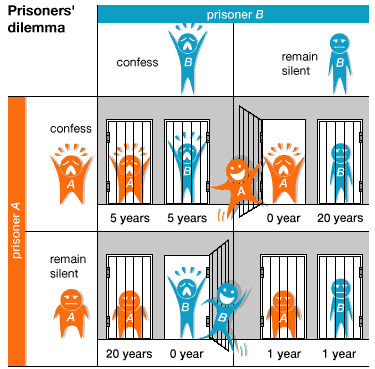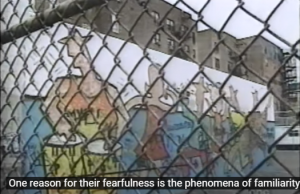Artifact 3
Out of Modules 11-14, I felt the most engaged with the Item to Archive for Module 13. Module 13 is centered on groups and individuals, and the item to archive was an exercise that focused on social dilemmas, specifically the prisoner’s dilemma. I browsed through a website that allowed me to run simulations of the prisoner’s dilemma. I got to control whether either or both of the prisoners confessed or stayed silent. This artifact was the most engaging for me because it involved a simple yet effective exercise, and participating in it allowed me to have a better grasp of how social dilemmas operate. The image below shows the different outcomes of the prisoner’s dilemma. I picked this image because it provides a clear picture of how the prisoner’s dilemma works and what the potential gains and losses are for each prisoner.
By doing this exercise, I was able to learn about the concept of social dilemmas, in which one person can maximize their own gains if they act selfishly, but if everyone else also takes the selfish route, they risk losing out on the benefits. I had assumed that it would be logical for those in a social dilemma to cooperate instead of compete, because of the risk of punishment. But doing the the exercise expanded my knowledge of the prisoner’s dilemma and helped me understand why it is possible for people to compete, aka act selfishly and confess. Being aware of harsh sanctions can make people feel lower trust and cooperation, and they may choose to act in their own self-interests. For example, in this scenario, competing may lead to either 5 years or no years in prison, depending on what action the partner takes. But if you cooperate, you risk getting either 1 year or 20 years in prison, the latter being the harshest of all four outcomes. Since you have no idea what decision your partner will make, you may feel inclined to confess in order to avoid the risk of the worst outcome, and possibly get the best-case scenario, which is to get no prison time.

Artifact 2
Out of Modules 7-10, the Item to Archive that was the most engaging for me was the item from Module 7. Module 7 is focused on cognitive dissonance, which is a topic that I briefly learned about in another class that I took, but I got to learn about it in more detail in this module. I picked this item because the exercise made me more aware of how consistent my behaviors actually are in relation to my attitudes. First, I took an attitude survey in which I identified how strongly I agreed or disagreed with various statements about my personal beliefs. Then I took a behavior survey to reveal what actions I actually take in my daily life. I experienced a moment of cognitive dissonance when I realized that some of my attitudes did not align with my behavior. For example, I believe that engaging in regular exercise is important for one’s health, but I don’t actually work out on a daily basis. I coped with this moment of cognitive dissonance by simply telling myself that I would resolve to exercise more in the future, when I have more time. This exercise made me learn more about what strategies I use to cope with experiencing moments of cognitive dissonance.
The item also expanded my knowledge on the subject of cognitive dissonance. When experiencing a feeling of cognitive dissonance, people will cope with the experience in direct and indirect ways. One direct way of resolving the feeling of cognitive dissonance is to simply resolve to change your behavior in the future, just as I did. Another direct method is to try to dismiss the inconsistency between the attitude and behavior as being unimportant. An indirect way of resolving dissonance is to reaffirm positive traits that may be threatened by the feeling of inconsistency. Learning about the various ways that people cope with cognitive dissonance made me realize that being confronted with the truth is an uncomfortable feeling for many people. This is why I chose to display Friedrich Nietzsche’s quote below, which emphasizes how people avoid the truth because it may change the way they view themselves.

Artifact 1
Out of each of the Items to Archive from Modules 3-6, the artifact that engaged me the most was the item from Module 4. Module 4 focused primarily on social cognition, and this item helped me gain a better understanding of the topic. I watched a video that discussed how the media can influence our use of the representative heuristic and availability heuristic, especially in regard to crime. I picked this item because it connected with me the most, since I sometimes let the media influence my perception on topics such as crime rates. Our perception of what a criminal looks like is based on the prototypes we develop in our mind, and the media has a strong influence on what prototypes we form. Biased media coverage can end up affecting how strongly people rely on use of the representative heuristic, even if the prototypes they are comparing objects or people to are inaccurate. Also, since news reports focus on dramatic event, people who watch the news will be able to easily recall these shocking moments. This affects the availability heuristic because the more easily people recall events, they believe that they occur more frequently than they do.
The screenshot below shows a statement from the video that stood out to me. The statement is about how people are often fearful of things that they are not familiar with. People may be scared of places like New York, believing that it is a crime-infested city. But this fear also exists because people tend to ignore base rates. Base rates refer to how often an event actually occurs in the world. If people familiarized themselves with base rates, they would be able to overcome the influence of the media. This activity not only expanded my knowledge on topics such as heuristics and base rates, but it also helped me realize just how strongly the media influences the heuristics we use. Now I am more aware of how often I rely on heuristics, and that I should not let news reports warp my perception of what criminals look like or how often crime actually occurs in certain parts of the world.
